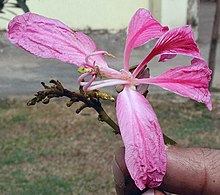Bauhinia purpurea
| Phanera purpurea | |
|---|---|
 |
|
| Flower at Kolkata, West Bengal, India. | |
| Scientific classification | |
| Kingdom: | Plantae |
| (unranked): | Angiosperms |
| (unranked): | Eudicots |
| (unranked): | Rosids |
| Order: | Fabales |
| Family: | Leguminosae |
| Genus: | Phanera |
| Species: | P. purpurea |
| Binomial name | |
|
Phanera purpurea (L.) Benth. |
|
| Synonyms | |
|
|
Phanera purpurea is a species of flowering plant in the family Fabaceae, native to South China (which includes Hong Kong) and Southeast Asia. Common names include orchid tree,Hong Kong orchid tree,purple bauhinia,camel's foot,butterfly tree, and Hawaiian orchid tree.
Phanera purpurea is a small to medium-size deciduous tree growing to 17 feet (5.2 m) tall. The leaves are 10–20 centimetres (3.9–7.9 in) long and broad, rounded, and bilobed at the base and apex. The flowers are conspicuous, pink, and fragrant, with five petals. The fruit is a pod 30 centimetres (12 in) long, containing 12 to 16 seeds. Leaves are alternate.
In the United States of America, the tree grows in Hawaii, coastal California, southern Texas, and southwest Florida. Bauhinia blakeana is usually propagated by grafting it onto P. purpurea stems.
Phanera purpurea is called Mandarai in Tamil and is used in traditional Tamil medicine in India.
A wide range of chemical compounds have been isolated from Phanera purpurea including 5,6-dihydroxy-7-methoxyflavone 6-O-β-D-xylopyranoside, bis [3',4'-dihydroxy-6-methoxy-7,8-furano-5',6'-mono-methylalloxy]-5-C-5-biflavonyl and (4'-hydroxy-7-methyl 3-C-α-L-rhamnopyranosyl)-5-C-5-(4'-hydroxy-7-methyl-3-C-α-D-glucopyranosyl) bioflavonoid, bibenzyls, dibenzoxepins, mixture of phytol fatty esters, lutein, β-sitosterol, isoquercitin and astragalin.
...
Wikipedia
